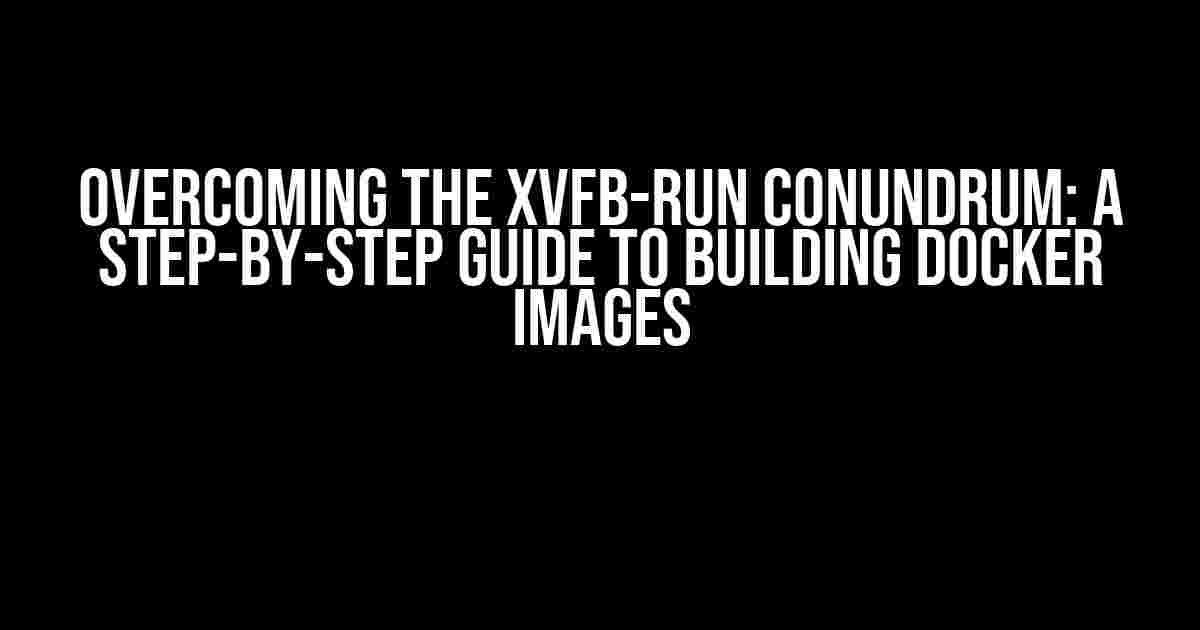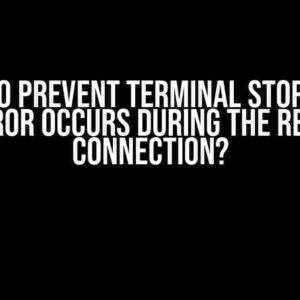Are you tired of hitting a roadblock while building Docker images due to the infamous “Can’t use xvfb-run twice” error? You’re not alone! This article is here to guide you through the trenches and provide a clear, comprehensive solution to overcome this hurdle. Buckle up and let’s dive into the world of Docker image building!
What is xvfb-run and Why Do We Need It?
xvfb-run is a utility that allows you to run graphical applications in a headless environment, which is essential for building Docker images that require graphical dependencies. It creates a virtual framebuffer, enabling your application to render graphics even when there’s no physical display attached.
In the context of Docker image building, xvfb-run is often used to install graphical packages, such as GUI libraries or web browsers, that require a display to function properly. However, this is where the trouble begins…
The Problem: “Can’t use xvfb-run twice”
When you try to use xvfb-run multiple times within the same Docker build process, you’ll encounter the dreaded “Can’t use xvfb-run twice” error. This occurs because xvfb-run can only be initialized once per build process. Attempting to re-run it will result in a conflict, causing your build to fail.
This limitation can be frustrating, especially when you need to install multiple graphical dependencies that require xvfb-run. Fear not, dear reader, for we have a solution!
Solution: Using Multi-Stage Builds and xvfb-run judiciously
To overcome the “Can’t use xvfb-run twice” issue, we’ll employ a clever technique involving multi-stage builds and strategic xvfb-run usage. Follow these steps to build your Docker image successfully:
Step 1: Create a Separate Stage for xvfb-run
Begin by creating a new stage in your Dockerfile, specifically designed for xvfb-run. This stage will be responsible for installing graphical dependencies that require xvfb-run.
# Create a new stage for xvfb-run
FROM ubuntu:latest as xvfb-stage
# Install xvfb and required dependencies
RUN apt-get update && \
apt-get install -y xvfb libxvfb1 libssl1.0.0 libgtk2.0-0 libxtst6 && \
rm -rf /var/lib/apt/lists/*
# Set the DISPLAY environment variable
ENV DISPLAY=:99.0
Step 2: Run xvfb-run Once and Only Once
In this stage, we’ll run xvfb-run once to install the required graphical dependencies. Be careful not to run xvfb-run again in subsequent stages, as this will trigger the error.
# Run xvfb-run to install graphical dependencies
RUN xvfb-run -a --server-args "-screen 0 1024x768x24" \
apt-get update && \
apt-get install -y firefox && \
rm -rf /var/lib/apt/lists/*
Step 3: Create Another Stage for the Final Image
Create a new stage that will serve as the final image. This stage will inherit from the previous xvfb-stage, but won’t require xvfb-run.
# Create the final stage
FROM xvfb-stage as final-image
# Install additional dependencies required for the application
RUN apt-get update && \
apt-get install -y openjdk-8-jdk && \
rm -rf /var/lib/apt/lists/*
# Set the working directory and copy application files
WORKDIR /app
COPY . /app/
# Expose the port and define the command to run the application
EXPOSE 8080
CMD ["java", "-jar", "application.jar"]
Benefits of Multi-Stage Builds
By using multi-stage builds, you can efficiently separate concerns and optimize your Docker image building process. Here are some benefits:
- Reduced image size**: Each stage can be optimized for a specific task, resulting in a smaller final image.
- Faster build times**: You can cache intermediate stages, reducing the build time for subsequent stages.
- Improved maintainability**: With separate stages, it’s easier to update or modify specific parts of the build process without affecting the entire image.
Conclusion
Voilà! You’ve successfully overcome the “Can’t use xvfb-run twice” hurdle and built a Docker image that incorporates graphical dependencies. By employing multi-stage builds and strategic xvfb-run usage, you can efficiently create robust and efficient Docker images.
Remember, Docker image building is an art that requires patience, creativity, and a dash of problem-solving skills. With this guide, you’re one step closer to becoming a Docker master!
| Stage | Purpose |
|---|---|
| xvfb-stage | Installs graphical dependencies using xvfb-run |
| final-image | Creates the final image, inheriting from xvfb-stage |
For your convenience, here’s a summary of the solution in a concise format:
- Create a separate stage for xvfb-run (xvfb-stage)
- Run xvfb-run once to install graphical dependencies in xvfb-stage
- Create another stage for the final image (final-image)
- Inherit from xvfb-stage and install additional dependencies in final-image
- Optimize and finalize the Docker image in final-image
Now, go forth and build those Docker images with confidence!
Frequently Asked Question
Some burning questions about using xvfb-run while building a Docker image? We’ve got you covered! Read on to find the answers!
Q: Why can’t I use xvfb-run twice in my Dockerfile?
Ah-ha! That’s because xvfb-run launches a new X server instance, and running it twice would try to start a new X server on top of the previous one, leading to conflicts and a failed build process. You gotta be gentle with those Docker images, buddy!
Q: Can I use xvfb-run with other commands in my Dockerfile?
Yes, you can! xvfb-run is a wrapper command that allows you to run other commands, like your application or tests, in a headless environment. Just make sure to use it wisely, as it might affect the behavior of your application or tests.
Q: How do I avoid running xvfb-run twice in my Dockerfile?
Easy peasy! Just remove any duplicate xvfb-run commands or wrap all your commands in a single xvfb-run invocation. You can also use a script to manage your xvfb-run commands and ensure they’re only executed once.
Q: What if I need to run multiple commands that require xvfb-run?
No problemo! You can use xvfb-run with command grouping, like `xvfb-run bash -c “command1 && command2 && command3″`, or create a script that runs all your commands and invoke xvfb-run only once on that script.
Q: Is there an alternative to xvfb-run for headless rendering?
Yessiree! You can use other tools like Xvnc, Xephyr, or even Docker’s built-in support for headless rendering with the `–privileged` flag. Each has its own pros and cons, so choose the one that fits your needs best!


